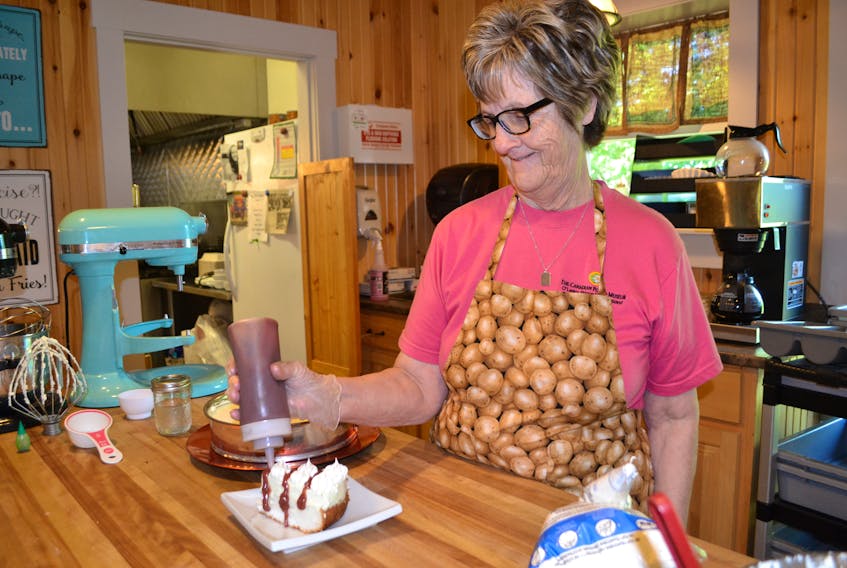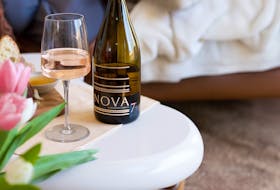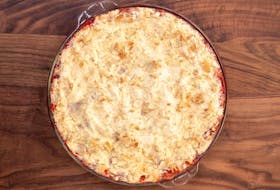O'LEARY, P.E.I. — Nick Doucette has prepared more seaweed pies than, perhaps, anyone else on earth.
It helps that she is one of only two keepers of the seaweed pie recipe.
“A lot of people come in here and they expect to see seaweed hanging out of it,” said Doucette, the dessert-maker at the Country Kitchen restaurant. It is believed it's the only restaurant on P.E.I. with seaweed pie still on the menu.
Country Kitchen is located in the Canadian Potato Museum in O’Leary, P.E.I., and aside from the pie, the restaurant prides itself on potato dishes.
Despite the missing pieces of seaweed on their plate, Doucette says diners tell her the pie is delicious.
“It is a very light dessert,” she said.

The pie’s origin comes from Miminegash, P.E.I., near the Island's northern tip, which was long-regarded as the Irish Moss Capital of the World.
Doucette mourns the era when Irish Moss was a big part of Miminegash’s economy. She fears the harvests by the truckload are gone for good.
Irish moss (Chondrus crispus) is a seaplant from which a starch-like substance called carrageenan is extracted. Carrageenan is used in many consumer products including ice cream, beer, salad dressing, shampoo, toothpaste and cosmetics. Western P.E.I. was once known worldwide for its Irish moss. It was harvested by fishing boats and also gathered up along the beaches following wind storms. Horses dragging large scoops would go out in the tidal wash to gather it.
Irish moss has been all but smothered out by other seaweeds such as Furcellaria, or there are so many other seaweeds mixed in with it that it's difficult to harvest commercially anymore.
Today, Doucette's husband, Carl, gathers up individual pieces of moss for her during his walks on the beach.
After washing the moss numerous times, she places small quantities in a pot of water and boils it down until she can strain off the remaining liquid as a clear gel for use in her pies.
There were variations of the seaweed pie recipe around Miminegash for decades, but the group Women in Support of Fishing refined the recipe to become the sought-after dessert at the Seaweed Pie Café and Interpretative Centre which Women in Support of Fishing operated in Miminegash from 1994 to 2012.
Back in the '90s Nick Doucette and Louanne Gallant trained with a consultant to prepare the pie recipe for the group's community development and tourism venture. They are the keepers of the recipe and are not prepared to share.

Gallant said she’s thrilled that the pie is still being served long after their café closed.
She tells of being approached about sharing the recipe and of their determination to safeguard it.
“That’s our calling card,” she said.
Like Doucette, Gallant misses the days when Irish moss drew harvesters to Miminegash’s sandy shores.
“When I walk on the beach, I will sometimes see the moss and I will pick it up and it’s so exciting, because I’d wish those days were back.”
Gallant, who works the front counter at the potato museum, says she greeted guests just last week who lamented they could not find seaweed pie since the café in Miminegash closed.
They were pleased to learn of its availability at the Country Kitchen.
“Is there actually seaweed in it? Will we see the seaweed? How is it made?” are some of the questions diners ask.
Another restaurant worker, Karen Murray, said visitors from Ontario have bought whole pies to take home with them.
The pie has a made-in-restaurant sponge cake for a base, onto which a mixture that includes whipping cream, the carrageenan gel from the Irish moss and a scoopful of powder – the secret ingredient.
“Can’t say,” said Doucette, when asked about it.
After the mixture is whipped up, it’s layered onto the sponge cake. Once portioned into pie shapes, staff squeeze on another topping and then complete the dessert with a strawberry or blueberry sauce.
The blueberry bread pudding rivals seaweed pie as the dessert of choice at the Country Kitchen, Doucette said it may be because diners are not familiar with the pie’s origin.
She prepares three to four seaweed pies a day at the Country Kitchen, but back in the Seaweed Pie Café days, it was not unusual to go through eight to 10 pies a day.
“Just the name, they wanted to see what it was."
People who aren't from western P.E.I., may recall the name from this commercial:









